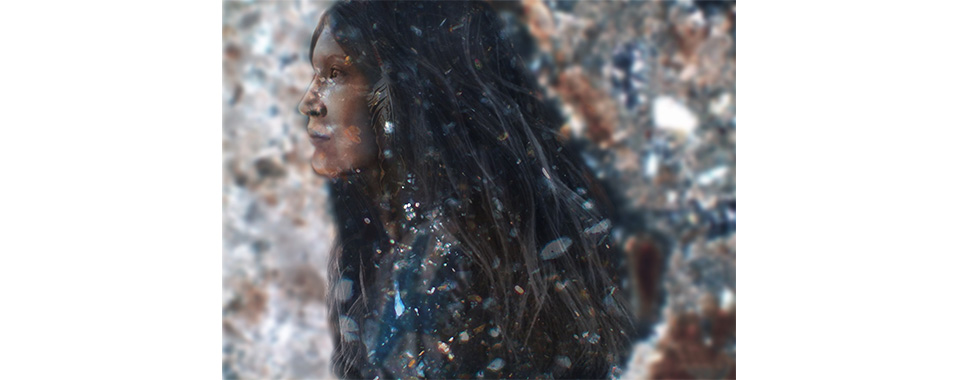Thursday, July 21, 2022 – The photographic exhibition “Transforming the Invisible: from archaeological photomicrography to digital painting” is an artistic attempt to transition from the “visible,” tangible world to the “invisible” microcosm.
This is a collaboration between visual artist Aggeliki Kourmoulaki and archaeologist Stella Kyrillidou, two women who examine the traces from the Earth’s interior and interpret them in their own ways. The exhibition includes 46 visual works created using digital media, representing transformations of archaeological research photographs. These photographs come from samples of sediments specifically prepared for scientific study using the method of micromorphological analysis. These samples have been collected from prehistoric settlements in Western and Central Macedonia (Agi Kastoria, Kleitos Kozani, Arhontiko Giannitsa, Toumpa Thessaloniki) and originate from residential spaces (streets, courtyards, animal pens, hearths, ovens, construction platforms). They capture traces that are not visible to the naked eye and concern the microscopic structure and composition of plant and animal remains (phytoliths, seeds, bones, ashes, animal dung, coproliths), as well as remains of mineral origin (clay fragments, various minerals, and rocks).
The majority of the photographs are taken from slides (thin sections of 30 microns) measuring 14x7cm, enlarged up to 500 times (500x), using the latest generation Leica 2500P microscope of the research program “Thalis” at AUTH (supervised by Professor Kostas Kotsakis). Additionally, photographs from the natural size of the material (micromorphological blocks impregnated in resin) and from various stages of its preparation (coarse sections of micromorphological blocks) have been used. These images add magic to the already fascinating work of the archaeologist, transforming when seen through the artist’s eye. In this case, artistic processing maintains the basic lines and shapes of the original image, giving a specific form to abstract shapes. As a result, human, animal, and landscape figures are revealed as microscopic postcards embedded within the microstructure of the findings, suggesting that nature always reproduces the same forms on both small and large scales.
The digital panels are exhibited alongside their corresponding photomicrographs, creating an open dialogue between the two versions: artistic inspiration next to scientific representation, bridging the gap between the “invisible” microcosm and the “visible” realms of scientific and artistic revelation. Ultimately, the past is connected to the present, microscale meets macroscale, and logic converses with imagination. Simultaneously, the exhibition offers visitors the opportunity to become familiar with the scientific method of preparing samples, from their collection at the archaeological site to their final transparent state. Certainly, it’s a journey where one can appreciate the human creation alongside the artistic interpretation of natural forces through the remnants of ancient life, resulting in true works of art.
The exhibition is hosted in Hall G of the Archaeological Museum of Thessaloniki and will run from July 21 to September 30, 2022, with daily operating hours from 08:00 to 20:00.
For more information, you can contact the museum at 2313 310201 or visit their website www.amth.gr, as well as their social media channels.
Aggeliki Kourmoulaki was born and lives in Thessaloniki. She studied at the Department of Preschool Education of the University of the Aegean. She pursued private studies in visual arts and continues her personal research. Among other things, she has been systematically involved in teaching visual arts and scenography, presenting her work in 9 solo and 23 group exhibitions of painting, artistic masks, and constructions. She is a member of the Chamber of Fine Arts of Greece.
Stella Kyrillidou studied Archaeology at the Aristotle University of Thessaloniki. She holds a PhD from the University of Reading in the UK. She works as a micromorphologist in new prehistoric excavations of the Archaeological Service in Macedonia. She is a scientific collaborator of excavations at AUTH and a researcher in the European program EXPLO-Dispilio.
Return to the main page
of ARC – Art Revisited Collective






